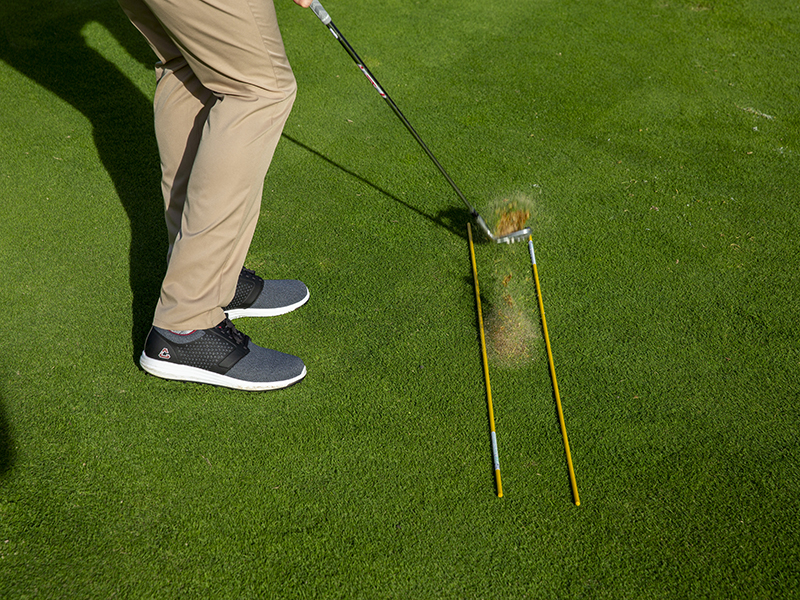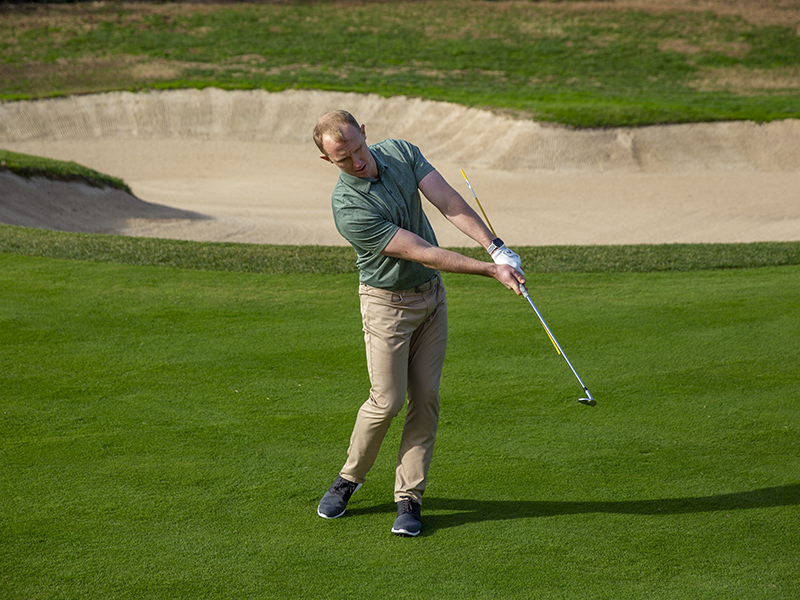
We often see tour pros throw darts with their wedges from inside 100 yards, and many of us wish we could replicate their precision and consistency. The distance wedge triangle is a simple process that will help you to improve your approach play, and get you dialled in from this crucial distance.
In this article and video, Golf Monthly Top 50 Coach John Howells explains everything you need to know about this useful three-step concept...
What is the distance wedge triangle?
The distance wedge triangle is made up of three aspects: centeredness of strike, a low dynamic loft at impact, and distance control.
Coaches often focus on the third component, swing length, but the other two have typically been neglected, so we will focus on those in this piece. Perfecting the distance wedge triangle will help you to get dialled in from inside 100 yards, which is a key distance for creating birdie opportunities and ultimately shooting lower scores.
1. Centeredness of strike
With this aspect we are looking to hit the ball out of the horizontal centre, so not the toe or the heel of the club. We are also looking to find the vertical centre of the clubface, therefore avoiding fat and thin shots.
To achieve this, we need to focus on a few things at set-up. The ball should be just forward of centre, with your left foot slightly flared out. Your weight needs to be just marginally on your left side, and I don't mind encouraging a little forward shaft lean.
Once in this position, make a nice centred backswing. Try not to sway your head off the ball, or transfer your weight excessively over to you right side. Aim to hit the ball before making contact with the ground, so that you get that nice compressed contact with the ball.

To practice this, you can set-up the runway drill. This focuses on getting the club to land in the horizontal position correctly. As you can see in the video above, place two alignment sticks on the ground to create a runway, just wider than the width of the clubhead.
Take a few practice swings, aiming to hit the ground in the centre of the runway. If you hit either alignment stick, reset and start again. If you can consistently find the middle of the runway, this will promote increased control, an optimal launch and better strikes.
2. Low dynamic loft
The second aspect of the triangle is creating that lovely low dynamic loft. The best players de-loft their wedge shots around 15 degrees from roughly 70 yards.
We are trying to make sure we have plenty of shaft lean through impact. If I took a 58 degree wedge, I would be looking to de-loft this to around 43 at impact, as this will give us a low launch angle and high spin, which will allow the ball to get that nice 'one hop and stop' landing on the greens.

I like to use the alignment stick drill to practice this. Grip your club with the alignment stick next to it, as you can see in the video above. Take your normal grip, and make sure the alignment stick is just outside your left hip.
This invokes a nice amount of forward shaft lean, even at address, which helps with the drill. When I make my swing, I am looking to avoid the alignment stick hitting the rib cage on my left hand side.
Make short swings back and through, as a drill, trying to brush the ground with a low dynamic loft. You can then remove the stick, and try putting that feel into practice with a normal swing.
3. Distance control
This element focuses on the clubhead speed, which controls the ball speed and how far the shot carries.
The clock system, which is regularly used as a key pitching drill, allows us to focus on where our left arm would be pointing on a clock face in our backswing.
If you imagine your arm started in the address position at six o'clock, you can then swing back using different lengths to eight, ten or even a full backswing. Those altered length backswings will give you three different clubhead speeds.

When practicing this, you can call it whatever you like. Some go with 'small, medium and large swing', and others like to go with 'half, three-quarter and full'. It really doesn't matter, but it is important to know how far each of those three shots goes for you personally.
I would recommend getting the numbers written on the back of your wedge, just like I have done in the picture above, as this will allow you to practice hitting those distances at the range.
Put all three aspects of the distance wedge triangle into your game, and you will see a much closer proximity to the hole and plenty of great birdie opportunities.







